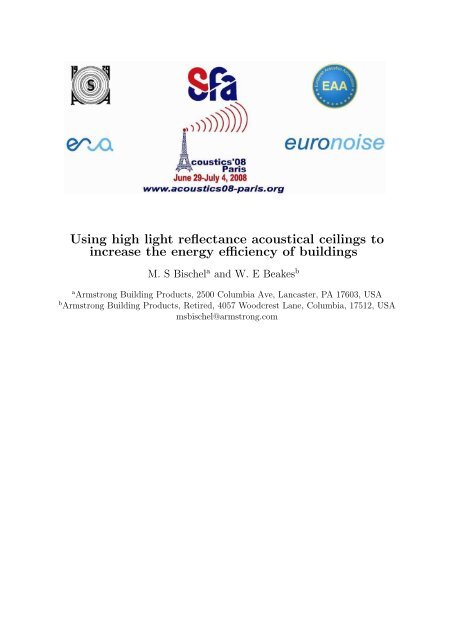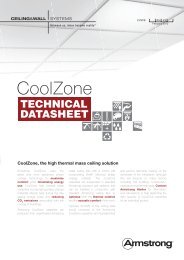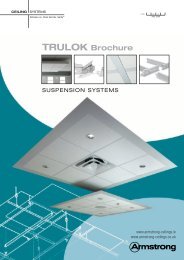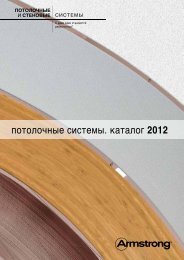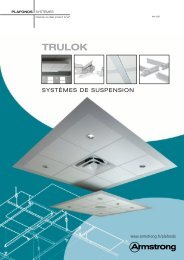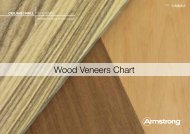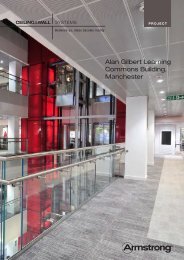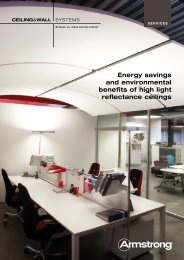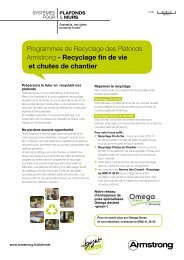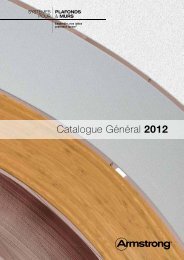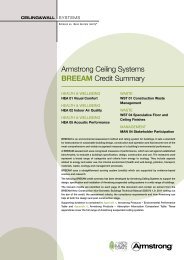Using high light reflectance acoustical ceilings to increase the ...
Using high light reflectance acoustical ceilings to increase the ...
Using high light reflectance acoustical ceilings to increase the ...
You also want an ePaper? Increase the reach of your titles
YUMPU automatically turns print PDFs into web optimized ePapers that Google loves.
<strong>Using</strong> <strong>high</strong> <strong>light</strong> <strong>reflectance</strong> <strong>acoustical</strong> <strong>ceilings</strong> <strong>to</strong><strong>increase</strong> <strong>the</strong> energy efficiency of buildingsM. S Bischel a and W. E Beakes ba Armstrong Building Products, 2500 Columbia Ave, Lancaster, PA 17603, USAb Armstrong Building Products, Retired, 4057 Woodcrest Lane, Columbia, 17512, USAmsbischel@armstrong.com
Acoustical <strong>ceilings</strong> with white, <strong>high</strong>ly <strong>light</strong>-reflecting surfaces can be used as an effective, passive means <strong>to</strong>significantly improve <strong>the</strong> energy efficiency of a space. When a ceiling with <strong>high</strong> <strong>light</strong> <strong>reflectance</strong> is coupledwith an indirect <strong>light</strong>ing system, illumination can be <strong>increase</strong>d by 20% or <strong>the</strong> energy directly associated with<strong>light</strong>ing can be reduced by 20%. In addition, lower <strong>light</strong>ing loads can reduce cooling costs by 7%. A <strong>high</strong>ly<strong>light</strong> reflective ceiling can also be used <strong>to</strong> reflect day<strong>light</strong> in<strong>to</strong> a space, increasing <strong>the</strong> amount of <strong>light</strong> in interiorareas away from <strong>the</strong> windows by as much as 20%; alternatively, <strong>the</strong> surface area of windows may be reduced by11% while maintaining <strong>the</strong> same illumination levels. In all cases, <strong>the</strong> <strong>increase</strong>d <strong>reflectance</strong> of <strong>light</strong> allows <strong>the</strong>number of fixtures <strong>to</strong> be decreased, fur<strong>the</strong>r increasing <strong>the</strong> savings related <strong>to</strong> initial cost, energy use andmaintenance. The percentage of energy savings associated with <strong>light</strong>ing is proportional <strong>to</strong> <strong>the</strong> percentage<strong>increase</strong> in <strong>the</strong> ceiling’s <strong>light</strong> <strong>reflectance</strong> value; <strong>the</strong>refore, even small <strong>increase</strong>s in <strong>light</strong> <strong>reflectance</strong> provideenergy savings. When <strong>the</strong> <strong>acoustical</strong> performance of two products is comparable, <strong>light</strong> <strong>reflectance</strong> could be acritical differentia<strong>to</strong>r in determining <strong>to</strong>tal building performance and occupant comfort.1 IntroductionAs a result of efforts <strong>to</strong> reduce <strong>the</strong> environmental impact ofbuildings, <strong>the</strong>re has been an emphasis placed on <strong>the</strong> use ofmaterials that can <strong>increase</strong> <strong>the</strong> energy efficiency of a space.There has been a simultaneous effort by some specifiers <strong>to</strong>reduce <strong>the</strong> material usage in a space, in <strong>the</strong> belief that usingless material is better for <strong>the</strong> environment. Frequently, oneof <strong>the</strong> first casualties of dematerialization is <strong>the</strong> traditional<strong>acoustical</strong> ceiling; if o<strong>the</strong>r <strong>acoustical</strong>ly absorptive materialsare not included in <strong>the</strong> space, <strong>the</strong> acoustic comfort andproductivity of <strong>the</strong> occupants will be compromised. Forexample, open office spaces with no <strong>acoustical</strong> ceilingtreatment suffer from long reverberation times and reducedspeech privacy; both of <strong>the</strong>se will adversely affect workerproductivity and comfort. Studies of indoor environmentshave linked poor acoustics <strong>to</strong> <strong>increase</strong>d worker distractionsand lowered productivity [1, 2, 3].What is less obvious is that <strong>the</strong> elimination of <strong>the</strong>suspended ceiling can also create a space that is not asenergy efficient as it might be. A <strong>high</strong>ly <strong>light</strong> reflectiveceiling plane can be used as part of <strong>the</strong> <strong>light</strong>ing strategy for<strong>the</strong> space, helping <strong>to</strong> enhance both natural and artificial<strong>light</strong> within <strong>the</strong> space, and reducing <strong>the</strong> energy associatedwith <strong>light</strong>ing.The United States Department of Energy has published datashowing that <strong>light</strong>ing fixtures are <strong>the</strong> largest users of energyin American office buildings, and <strong>the</strong> second largest incommercial buildings overall, using 23-29% of <strong>the</strong> <strong>to</strong>talenergy consumed [4]. The ability <strong>to</strong> use a single product <strong>to</strong>significantly reduce <strong>the</strong> energy used <strong>to</strong> <strong>light</strong> a space whileproviding <strong>acoustical</strong> conditions that can <strong>increase</strong> workerproductivity is a powerful argument in favor of <strong>the</strong> use ofsuspended <strong>acoustical</strong> <strong>ceilings</strong>.2 The role of an acoustic ceiling insaving energyThere are several ways in which a suspended <strong>acoustical</strong>ceiling can be used <strong>to</strong> save energy in a building. First,many <strong>acoustical</strong> <strong>ceilings</strong> are manufactured from insulatingmaterials such as fiberglass, rock wool, and slag wool (<strong>the</strong>latter two are generically known as mineral wools). Thepublished <strong>the</strong>rmal insulation values for <strong>the</strong>se products rangefrom 0.26 – 0.30 m 2 W/K for mineral wool products <strong>to</strong> 0.62m 2 W/K for fiberglass products. However, given <strong>the</strong> factthat <strong>ceilings</strong> tend <strong>to</strong> be thin (less than 20 mm is typical) <strong>the</strong>actual insulating effect is somewhat minimal.A suspended ceiling can play a role in energy savings whenit is used as a component of <strong>the</strong> air distribution system.Modelling work commissioned by <strong>the</strong> Ceilings and InteriorSystems Construction Association (CISCA) found that <strong>the</strong>use of a suspended ceiling as part of a return air plenumHVAC system (a common building practice in <strong>the</strong> UnitedStates) reduced <strong>the</strong> energy <strong>to</strong> operate an office space by 5 –7.6% as compared <strong>to</strong> an open plenum design for <strong>the</strong> samespace. This is largely due <strong>to</strong> <strong>the</strong> need for reducedhorsepower fans, and an <strong>increase</strong>d ability <strong>to</strong> remove heatfrom <strong>light</strong>ing fixtures [5].There is a third attribute of suspended <strong>acoustical</strong> <strong>ceilings</strong>that can have a profound impact on <strong>the</strong> energy efficiency of<strong>the</strong> space: <strong>light</strong> <strong>reflectance</strong>. Light Reflectance, or LR, is aphysical property that represents <strong>the</strong> percentage of incidentilluminance that is reflected off a flat surface after beingdirected at that surface. For example, a surface with a <strong>light</strong><strong>reflectance</strong> value of 0.75 will reflect 75% of <strong>the</strong> incident<strong>light</strong> and absorb 25%. A surface with a <strong>light</strong> <strong>reflectance</strong>value of 0.90 reflects 90% of <strong>the</strong> <strong>light</strong>, absorbing only 10%.The <strong>light</strong> <strong>reflectance</strong> values of most white suspendedceiling products fall in <strong>the</strong> range of 0.75 – 0.90, asmeasured by ASTM E1477 [6] or ISO 7724-2 [7]. As <strong>the</strong>amount of texturing or fissuring <strong>increase</strong>s, <strong>the</strong> <strong>light</strong><strong>reflectance</strong> will decrease; <strong>the</strong> products with <strong>the</strong> <strong>high</strong>estvalues, greater than 0.85, tend <strong>to</strong> have smooth surfaces andare painted with <strong>high</strong> quality coatings containing <strong>high</strong>lyrefractive pigments such as TiO 2 . Non-white surfaces havemuch lower <strong>light</strong> <strong>reflectance</strong> values.Research has shown that a <strong>high</strong> LR ceiling can play asignificant role in enhancing energy efficiency in two mainways:1. The artificial illuminance generated by pendant oro<strong>the</strong>r indirect <strong>light</strong>ing fixtures is bettered scattered,increasing <strong>the</strong> quality and quantity of <strong>light</strong> available <strong>to</strong><strong>the</strong> space below. This in turns allows <strong>the</strong> number offixtures <strong>to</strong> be reduced, reducing <strong>the</strong> energy associatedwith <strong>light</strong>ing.2. Natural <strong>light</strong> from windows can be harvested morefully, reflecting this <strong>light</strong> deeper in<strong>to</strong> <strong>the</strong> interior of <strong>the</strong>space. This diminishes <strong>the</strong> need for artificial <strong>light</strong> in<strong>the</strong> space, and when used with a day<strong>light</strong> switching ordimming system strategy, <strong>the</strong> energy associated with<strong>light</strong>ing will be reduced.Recognition of <strong>the</strong> positive impact of <strong>light</strong> reflectivesurfaces on energy usage is addressed in <strong>the</strong> IESNAHandbook [8], and in recent updates <strong>to</strong> ASHRAE 90.1,
Energy Standard for Buildings Except Low-RiseResidential Buildings [9]. Both give recommended <strong>light</strong><strong>reflectance</strong> values for various surfaces.2.1 The Use of High LR <strong>ceilings</strong> withIndirect LightingWhen a <strong>high</strong> LR ceiling is used in conjunction with anindirect <strong>light</strong>ing system, <strong>the</strong> <strong>to</strong>tal illumination required for<strong>the</strong> space can be decreased [10, 11] because <strong>the</strong> ceilingplane becomes an integral part of <strong>the</strong> <strong>light</strong>ing distributionsystem. High LR <strong>ceilings</strong> have smooth finishes that diffuse<strong>light</strong> equally in all directions, greatly reducing offensiveglare, creating a more comfortably lit space for occupants.This property, known as uniformity, also improves <strong>the</strong>brightness ratio. When coupled with its inherent lowabsorption of incident <strong>light</strong>, a <strong>high</strong> LR ceiling <strong>increase</strong>s <strong>the</strong>effectiveness of <strong>the</strong> <strong>light</strong>ing system. This is turn reduces<strong>the</strong> number of fixtures needed in <strong>the</strong> space, reducing <strong>the</strong>energy needed <strong>to</strong> provide <strong>light</strong>.An extensive study commissioned by Armstrong andperformed by Brinjac Engineering evaluated <strong>the</strong> effect of<strong>high</strong> <strong>light</strong> <strong>reflectance</strong> <strong>ceilings</strong> on energy usage in buildings,when used in conjunction with indirect <strong>light</strong>ing systems[11]. The study eliminated <strong>the</strong> potential impacts of day<strong>light</strong>ing and task <strong>light</strong>ing within <strong>the</strong> space, and focused on<strong>the</strong> impact of <strong>the</strong> <strong>light</strong> <strong>reflectance</strong> value of <strong>the</strong> ceiling onceiling uniformity, work place illumination, and <strong>the</strong> ability<strong>to</strong> reduce energy while meeting <strong>the</strong> requirements of <strong>the</strong>IESNA Recommended Practices for Office Lighting.Atlanta, GA, was used at <strong>the</strong> locale.The results of this work show that by increasing <strong>the</strong> <strong>light</strong><strong>reflectance</strong> value of <strong>the</strong> ceiling from 0.75 <strong>to</strong> 0.90, <strong>the</strong>following improvements can be realized:• A <strong>high</strong>er LR value improved ceiling uniformityregardless of ceiling height, reducing glare and creatinga more comfortably lit space for <strong>the</strong> occupant.• There was a 22% <strong>increase</strong> in illumination within <strong>the</strong>workplace, when designed for maximum illumination.This <strong>increase</strong>s <strong>the</strong> effectiveness of <strong>the</strong> <strong>light</strong>ing design.• There was a 23% savings in <strong>light</strong>ing energy whendesigned for maximum energy savings.• There was a 7% decrease in energy consumptionassociated with <strong>the</strong> cooling system. In air conditionedbuildings, <strong>the</strong> heat generated by <strong>light</strong>ing fixtures adds<strong>to</strong> <strong>the</strong> overall heat load in <strong>the</strong> building. By reducing<strong>the</strong> number of <strong>light</strong> fixtures, less heat was generated,and less cooling was required.By using a <strong>high</strong> LR ceiling with an indirect <strong>light</strong>ing system,a building’s <strong>to</strong>tal energy use can be reduced by 10.6%.Work done by Yoon and Moeck shows significantreductions in <strong>light</strong>ing power density as <strong>the</strong> <strong>light</strong> <strong>reflectance</strong>of <strong>the</strong> ceiling is <strong>increase</strong>d [12].Analysis of <strong>the</strong> Brinjac data suggests that <strong>the</strong>re is a linearrelationship between <strong>the</strong> percent <strong>increase</strong> in <strong>the</strong> <strong>light</strong><strong>reflectance</strong> value of <strong>the</strong> ceiling and <strong>the</strong> percent decrease inenergy needed for <strong>light</strong>ing. A 5.9% <strong>increase</strong> in <strong>light</strong><strong>reflectance</strong> from 0.85 <strong>to</strong> 0.90 should result in an energysavings of approximately 6% [10]. Therefore, even smallchanges in <strong>light</strong> <strong>reflectance</strong> can have significant impacts onenergy use.The Weidt Group performed an extensive analysis of <strong>the</strong>overall <strong>light</strong>ing design of <strong>the</strong> newly built Keys<strong>to</strong>neBuilding in Harrisburg, PA. Their results show thatcombining a reflective <strong>acoustical</strong> ceiling with under floorair delivery helped <strong>increase</strong> <strong>the</strong> energy efficiency of <strong>the</strong>space: <strong>the</strong> uninterrupted ceiling plane reflected even more<strong>light</strong>, enabling <strong>the</strong> number of <strong>light</strong> fixtures <strong>to</strong> be decreased<strong>to</strong> a level that was 30% of amount originally specified. Theuse of a <strong>high</strong>ly <strong>light</strong> reflective ceiling was one componen<strong>to</strong>f an overall <strong>light</strong>ing design strategy for <strong>the</strong> building thatresulted in a 50% decrease in <strong>the</strong> energy associated with<strong>light</strong>ing [13]. This case study suggests that omitting a<strong>high</strong>ly reflective ceiling from spaces with under floor airsystems can result in <strong>high</strong>er energy usage than is needed,and that <strong>the</strong> use of <strong>high</strong> LR <strong>ceilings</strong> is an importantcomponent of <strong>the</strong> <strong>light</strong>ing strategy.2.2 The Impact of High LR <strong>ceilings</strong> withNatural LightingNatural <strong>light</strong>ing, or day<strong>light</strong>ing, is an important aspect for<strong>high</strong> performance spaces, improving energy efficiency [14]and increasing worker productivity [15]. Harvesting ofnatural <strong>light</strong> is a key component of effective <strong>light</strong>ingstrategies, and is frequently used in conjunction withdimming and au<strong>to</strong>matic switching systems. When a <strong>high</strong>LR ceiling is also used, <strong>the</strong>re is an additional positiveimpact on <strong>the</strong> <strong>light</strong>ing and energy use of <strong>the</strong> space.A <strong>high</strong>ly reflective ceiling plane acts <strong>to</strong> redirect, or harvest,natural <strong>light</strong> that enters a space through windows or off a<strong>light</strong> shelf. The <strong>light</strong> rays hit <strong>the</strong> uniform ceiling, and arereflected down evenly in<strong>to</strong> <strong>the</strong> occupied space. When noceiling is present, <strong>the</strong> <strong>light</strong> hits a surface that is typicallyrough, unfinished, and full of obstructions; <strong>the</strong> surface isalso frequently painted black. In this case, most of <strong>the</strong> <strong>light</strong>is absorbed by <strong>the</strong> dark surfaces, and <strong>the</strong> remainder ispoorly or unevenly reflected in<strong>to</strong> <strong>the</strong> space below.The <strong>increase</strong> in <strong>the</strong> amount of day<strong>light</strong> available associatedwith using a reflective ceiling can be measured. Weidtfound that <strong>the</strong> use of an LR 0.89 ceiling <strong>increase</strong>d by 15-20% <strong>the</strong> amount of day<strong>light</strong> in spaces that were 3.6 – 6.7 maway from a window, as compared <strong>to</strong> <strong>the</strong> levels when anLR 0.75 ceiling was used [16]. Yoon and Moeck found thatincreasing <strong>the</strong> ceiling <strong>light</strong> <strong>reflectance</strong> <strong>to</strong> 0.90 from 0.75<strong>increase</strong>d <strong>the</strong> day<strong>light</strong> fac<strong>to</strong>r in modeled spaces by 10%,regardless of <strong>the</strong> size of <strong>the</strong> window [12]. They also foundthat increasing <strong>the</strong> <strong>reflectance</strong> of <strong>the</strong> ceiling was moreeffective than increasing <strong>the</strong> <strong>reflectance</strong> of <strong>the</strong> walls,largely due <strong>to</strong> line-of-sight issues: <strong>the</strong> ceiling “sees” moreof <strong>the</strong> window area than do <strong>the</strong> walls [12]. These studiesshow that <strong>ceilings</strong> are effective at directing more day<strong>light</strong>more deeply in<strong>to</strong> occupied spaces, enhancing <strong>the</strong> natural<strong>light</strong> available <strong>to</strong> <strong>the</strong> occupants.Yoon and Moeck’s work also shows that if <strong>the</strong> <strong>light</strong><strong>reflectance</strong> of <strong>the</strong> walls is held constant (at LR 0.50) and<strong>the</strong> <strong>reflectance</strong> of <strong>the</strong> ceiling is <strong>increase</strong>d <strong>to</strong> 0.90 from 0.75,it is possible <strong>to</strong> reduce <strong>the</strong> area of <strong>the</strong> window glazing by11% and still achieve <strong>the</strong> recommended minimum day<strong>light</strong>fac<strong>to</strong>r of 2% (per USGBC’s LEED requirements) [12]. Inhot climates, this would allow a smaller window area <strong>to</strong> beused, lowering <strong>the</strong> <strong>the</strong>rmal load generated by solar heatingof <strong>the</strong> space, which would in turn lower cooling costs.
In <strong>the</strong> Keys<strong>to</strong>ne Building, Weidt found that <strong>the</strong> <strong>high</strong> LRceiling <strong>increase</strong>d <strong>the</strong> efficacy of <strong>the</strong> <strong>light</strong> shelves that directnatural <strong>light</strong> in<strong>to</strong> <strong>the</strong> space, helping <strong>to</strong> reduce electricalusage associated with <strong>light</strong>ing [13].So by effectively harvesting and redirecting natural <strong>light</strong> in<strong>the</strong> spaces away from windows, <strong>high</strong> <strong>light</strong> <strong>reflectance</strong><strong>ceilings</strong> can enhance <strong>the</strong> day<strong>light</strong>ing conditions of a space,reduce <strong>the</strong> number of <strong>light</strong> fixtures needed in spaces awayfrom <strong>the</strong> windows, and help <strong>to</strong> lower energy costs evenfur<strong>the</strong>r. At <strong>the</strong> same time, <strong>the</strong>y provide <strong>the</strong> proper acousticsneeded by <strong>the</strong> occupants, while meeting <strong>the</strong>ir needs fornatural <strong>light</strong>.3 Acoustical Performance v. LightReflectanceMost manufacturers of <strong>acoustical</strong> ceiling products publish<strong>the</strong> <strong>acoustical</strong> performance of <strong>the</strong>ir products: NRC, α w ,CAC and D ncw are commonly given in <strong>the</strong> literature. Manyacoustic professionals may not realize that most US andEuropean based manufacturers also list <strong>light</strong> <strong>reflectance</strong>values for <strong>the</strong>ir products. In general, <strong>the</strong> more <strong>high</strong>lytextured or fissured <strong>the</strong> product, <strong>the</strong> lower <strong>the</strong> LR value; asmooth, flat white surface will reflect <strong>the</strong> most <strong>light</strong>.However, a smooth flat surface also tends <strong>to</strong> reduce <strong>the</strong>absorption performance of a porous substrate if <strong>the</strong> paint isnot properly formulated and applied. An effective means ofcreating such a surface is described in a series of patents bySensenig et. al [17, 18, 19, 20].In Table 1, <strong>acoustical</strong> ceiling products currently being soldin North America, Europe, Asia and Australia arecategorized by type of texture, substrate type (slag wool,rock wool or fiberglass), <strong>the</strong> range of measured noisereduction coefficients, <strong>the</strong> range of measured <strong>light</strong><strong>reflectance</strong> values, and <strong>the</strong> range of advertised <strong>light</strong><strong>reflectance</strong> value. All sound absorption properties weremeasured according <strong>to</strong> ASTM C423 [21] using an E-400mounting in a NVLAP accredited facility (NVLAP lab code100228-0); <strong>light</strong> <strong>reflectance</strong> values were measuredaccording <strong>to</strong> ASTM E1477 [6] and are reported as anaverage of 9 measurements.Table 1: Noise Reduction Coefficient and Light Reflectance ValuesTexture and substrateMeasured Measured LR Advertised LR valuesNRC range rangeSmooth, painted veil on slag wool 0.65 – 0.85 0.70 - 0.90 0.89, 0.90, Up <strong>to</strong> 0.90Smooth, painted veil on fiberglass, rock wool,or mixtures of wool types0.80 – 0.95 0.81 – 0.90 0.85, 0.87, 0.88, 0.90,Up <strong>to</strong> 0.85Sand-like or dimpled on slag wool (lowabsorbing)0.10 – 0.40 0.83 – 0.89 0.87, Approx. 0.87,Up <strong>to</strong> 0.90Sand-like or dimpled on slag wool (standard 0.50 – 0.55 0.82 – 0.83 0.83, 0.84, 0.86, 0.88, 0.89absorption)Sand-like or dimpled on slag wool (<strong>high</strong>ly0.60 0.85 0.85absorbing)Sand-like or dimpled on cast mineral wool 0.70 0.77 0.81Textured or embossed on slag wool 0.55 – 0.70 0.80 – 0.87 0.82, 0.83, 0.84, 0.86Fissured and punched slag wool 0.30 – 0.70 0.79 – 0.90 0.82, 0.84, 0.85,> 0.75, ≥ 0.80,Approx. 0.85,Approx. 0.88,Up <strong>to</strong> 0.90The data in Table 1 show a wide variety in <strong>light</strong> <strong>reflectance</strong>values for similar <strong>acoustical</strong> absorption and appearance.Therefore, whenever possible, specifiers should choose <strong>the</strong>product with <strong>the</strong> <strong>high</strong>est measured <strong>light</strong> <strong>reflectance</strong> value inorder <strong>to</strong> lower <strong>the</strong> energy associated with <strong>light</strong>ing.Light <strong>reflectance</strong> is also an attribute for metal, wood andfabric covered <strong>ceilings</strong>. In Table 2, <strong>the</strong> <strong>light</strong> <strong>reflectance</strong> ofwhite metal <strong>ceilings</strong> are compared as a function of <strong>the</strong>percent open area created by round holes punched in<strong>to</strong> <strong>the</strong>surface. The panels all have a fiberglass veil on <strong>the</strong> back,and have an NRC value of 0.65, so this is a case whereaes<strong>the</strong>tics are driving <strong>the</strong> specification of <strong>the</strong> ceiling panel.The white paint is matched by <strong>the</strong> manufacturer <strong>to</strong> astandard colour specification. The percent open area of <strong>the</strong>samples was determined using image analysis performedwith ImagePro software.As shown, <strong>the</strong> <strong>light</strong> <strong>reflectance</strong> decreases in a linear fashionas <strong>the</strong> amount of open area is <strong>increase</strong>d. Also note thatwhen a white veil is used <strong>to</strong> back <strong>the</strong> panel, <strong>the</strong> LR value is<strong>increase</strong>d by 11% <strong>to</strong> 0.70 from 0.63, for <strong>the</strong> sameperforation pattern; <strong>the</strong>refore, switching from a black veil <strong>to</strong>a white veil would likely correspond <strong>to</strong> an <strong>increase</strong>d energysavings of approximately 10%.
Table 2: Light Reflectance v. Percent Open Area% openarea Average Light Reflectance0 0.839 ± 0.0051.43 0.741 ± 0.0037.9 0.692 ± 0.00411.4 0.682 ± 0.00916.4 0.627 ± 0.004 (black veil)16.4 0.698 ± 0.004 (white veil)22.2 0.614 ± 0.03922.5 0.584 ± 0.00223.4 0.570 ± 0.199Black paint .031 ± 0.0005Finally, Table 3 shows <strong>the</strong> impact on color on <strong>light</strong><strong>reflectance</strong>. The five products shown are all wall products,but comparable products are available for use in <strong>the</strong> ceiling.As <strong>the</strong> color darkens, <strong>the</strong> <strong>light</strong> <strong>reflectance</strong> value decreases.Table 3: Effect of Color on Light ReflectanceSample TypeAverageLRNRC, AmountingGray woven fabric onfiberglass board 0.390 0.80Beige woven fabric onfiberglass board 0.383 0.80Light blue woven fabric onfiberglass board 0.246 0.80Maple veneer, microperfed 0.382 0.45Light cherry veneer,microperfed 0.171 0.45The data shown in Tables 1, 2 and 3 clearly show that awide range of <strong>light</strong> <strong>reflectance</strong> values is available for<strong>acoustical</strong> <strong>ceilings</strong>. In order <strong>to</strong> optimize both <strong>the</strong> <strong>acoustical</strong>absorption and energy usage of <strong>the</strong> building, specifiersshould also consider <strong>the</strong> <strong>light</strong> <strong>reflectance</strong> properties of <strong>the</strong>product. Whenever possible, <strong>the</strong> specifier should choose<strong>the</strong> product with <strong>the</strong> <strong>high</strong>est measured <strong>light</strong> <strong>reflectance</strong>value in order <strong>to</strong> have <strong>the</strong> largest impact on <strong>the</strong> energyusage associated with <strong>light</strong>ing.4 ConclusionsA suspended, white, <strong>acoustical</strong> ceiling with a <strong>high</strong> <strong>light</strong><strong>reflectance</strong> value can enhance both <strong>the</strong> <strong>acoustical</strong>environment and <strong>light</strong>ing efficiency in a space. Suchreflective <strong>ceilings</strong> act as critical components in <strong>the</strong> <strong>light</strong>ingsystem, allowing <strong>the</strong> number of fixtures <strong>to</strong> be decreased,improving <strong>the</strong> uniformity of <strong>the</strong> dispersed <strong>light</strong>, anddirecting natural <strong>light</strong> fur<strong>the</strong>r in<strong>to</strong> interior spaces. All of<strong>the</strong>se fac<strong>to</strong>rs act <strong>to</strong> significantly decrease <strong>the</strong> energy used <strong>to</strong><strong>light</strong> <strong>the</strong> space, one of <strong>the</strong> largest energy uses in anycommercial building. Simultaneously, <strong>the</strong> <strong>high</strong> <strong>light</strong><strong>reflectance</strong> helps enhance occupant comfort andproductivity. Comparisons of commercially availableceiling products show that for <strong>the</strong> same <strong>acoustical</strong>absorption and appearance, <strong>the</strong> <strong>light</strong> <strong>reflectance</strong> can varywidely. Light <strong>reflectance</strong> should be considered as a criticaldifferentia<strong>to</strong>r in determining <strong>to</strong>tal building energyperformance and occupant comfort. In order <strong>to</strong> reduce <strong>the</strong>energy used <strong>to</strong> operate <strong>the</strong> space, <strong>the</strong> product with <strong>the</strong><strong>high</strong>est <strong>light</strong> <strong>reflectance</strong> value should be specifiedwhenever possible.AcknowledgmentsThe authors would like <strong>to</strong> thank <strong>the</strong> following individualsfor <strong>the</strong>ir collaborations: Shawn Good, Brinjac Engineering,Inc.; John Weidt, The Weidt Group; Youn Ju Yoon andMartin Moeck, formerly of <strong>the</strong> Pennsylvania StateUniversity Department of Architectural Engineering.References[1] Jensen, K., and E. Arens, “Acoustical Quality in OfficeWorkstations, as Assessed by Occupant Surveys,”Proceedings, Indoor Air 2005, p.2401.[2]National Research Council Canada, “WorkplaceDesign for Organizational Productivity,” 2004:http://irc.nrccnrc.gc.ca/pubs/fulltext/nrcc47343/nrcc47343.pdf[3] ASID, “Sound Solutions,” 1996.[4] 1995 and 2003 Commercial Buildings EnergyConsumption Survey, DOEhttp://www.eia.doe.gov/emeu/cbecs/contents.html[5] Donaldson, Barry, “Suspended Ceilings v. OpenPlenum – Life Cycle Study,” 2007.[6] ASTM E 1477-98a, “Standard Test Method forLuminous Reflectance Fac<strong>to</strong>r of Acoustical Materialsby Use of Integrating-Sphere Reflec<strong>to</strong>meters,” 1998.[7] ISO 7724/3, “Paints and Varnishes – Colorimetry –Part 3: Calculation of Color Differences,” 1984.[8] Rea, M. S., ed., IENSA Lighting Handbook, 9 th ed.,IESNA, 2000.[9] ASHRAE, Standard 90.1-2007, Energy Standard forBuildings Except Low-Rise Residential Buildings[10] EnergyDesignResources.com, “A Reflection of yourExpertise: New Ceiling Materials that Enhance <strong>the</strong>Efficiency of Your Lighting Design,” Issue 33, 2001.[11] Good, S., Brinjac Engineering, “Energy andEnvironmental Effects of High Light ReflectanceCeilings in Offices,” white paper,http://www.armstrong.com/common/c2002/content/files/38628.pdf[12] Yoon, Y-J and M. Moeck, “Impact of Ceiling and WallReflectance on LEED Credits,” Journal ofArchitectural Engineering, September 2005, Vol.11(3), pp. 81-90.
[13] Pennsylvania Governor’s Green Government Council,“A New Paradigm: High Performance IntegratedSystems,”http://www.gggc.state.pa.us/gggc/cwp/view.asp?a=515&q=156894[14] Bodart, M. and A. DeHerde, “Global Energy Savingsin Offices Building by <strong>the</strong> use of Day<strong>light</strong>ing,” Energyand Buildings, 34(2002) 421-429.[15] Heschong Mahone Group, Day<strong>light</strong>ing andProductivity Studies, 1999 – 2003: http://www.h-mg.com/projects/day<strong>light</strong>ing/summaries%20on%20day<strong>light</strong>ing.htm[16]“The Power of Light,” Lightnews, The Newsletter ofIESNA, BC Section 37, 10/2003:http://www.iesbc.org/content/publications/<strong>light</strong>news/LightNews%20Fall%202003.pdf[17] Sensenig, D. L., US Patent 5674594, 1997.[18] Pape, J. D. and D. L. Sensenig, US Patent 5874161,1999.[19] Sensenig, D. L., US Patent 5888626, 1999.[20] Sensenig, D. L., US Patent 6284351, 2001.[21] ASTM C423, “Standard Test Method for SoundAbsorption and Sound Absorption Coefficients by <strong>the</strong>Reverberation Room Method,” 2002.


